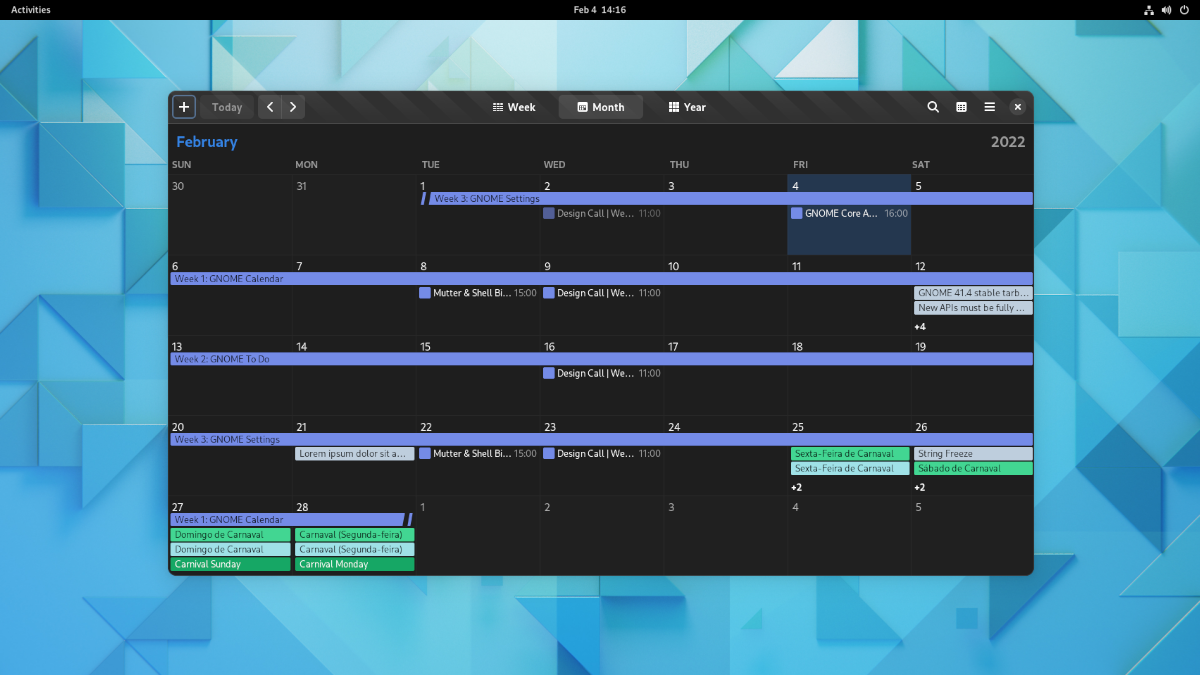
Ubuntu users probably don't quite understand what the GNOME project when in their news article this week they mention that the rounded edges have been removed. It makes perfect sense: Ubuntu's top panel is a long rectangular bar, but that's not the case on the original desktop. Right now, on the left and right there is a rounded part, and that is a change that they have advanced to us today.
El this week's article It's been titled "New Year, New Calendar," and well, it's not like they've made drastic changes. Rather, they have done what they are doing with many other applications: their design will be modified, but because they will start using GTK4. If all goes well, and nothing makes us think otherwise, it will arrive as part of GNOME 42 which will be released in March.
This week in GNOME
- La screenshot tool it has been submitted to be integrated into GNOME 42, although it still has a few things to tweak.
- The borders that were under the top panel have been removed, ensuring that that little detail will improve performance (more detail, here).
- GLib now supports property groups and token groups, which allow you to attach/detach multiple bindings or tokens to a GObject at once.
- GJS improvements:
- Support for WeakRef and FinalizationRegistry in the GNOME runtime. The project warns to use it with care, but they may offer some solutions to problems with circular references.
- BigInt values have been passed to GObject-introspected functions with 64-bit parameters. This way, you can finally work with large numbers that can't be stored precisely as a JS Number value and pass them correctly to C. For example, GLib.Variant.new_int64(2n ** 62n).
- Added the constants GLib.MAXINT64_BIGINT, GLib.MININT64_BIGINT and GLib.MAXUINT64_BIGINT to the GLib module.
- Fixed a bug that would break when passing the NONE Gdk.Atom value to a function.
- Gstreamer 1.20 has arrived after almost a year and a half of work. Most outstanding novelties:
- Development on GitLab changed to a single git repository containing all modules, and the development branch moved from master to main.
- GstPlay: new high-level playback library, replaces GstPlayer.
- Runtime support for libsoup2 and libsoup3 (support for libsoup3 is experimental).
- The new VA-API plugin implementation has been extended with more decoders and new post-processing elements.
- Support for AV1 hardware decoding has been added to the old VA-API vaapi plugin, the new VA-API va plugin, and the Intel Media SDK msdk.
- Video decoder subframe support.
- Smart encoding support (pass through) for VP8, VP9, H.265 in encodebin and transcodebin.
- Audio support for the WebKit Port for Embedded (WPE) web page source element.
- Numerous WebRTC improvements, such as automatic video decoder packet loss, data corruption, and keyframe request handling.
- More quick paths to video conversion software.
- Support for the Linux stateless CODEC has made it possible to obtain MPEG-2 and VP9.
- The mp4 and Matroska muxers now support profile/level/resolution changes for H.264/H.265 input streams (ie changing codec data on the fly).
- Lots of new plugins, features, performance improvements and bug fixes.
- They have introduced Workbench, a learning and prototyping application for GNOME development. It has GTK/CSS live preview.
- GStPipelineStudio 0.2.0 has been released.
- Now available lxi-tools v2.0, which is a collection of open source software for managing network connected LXI compatible test instruments such as modern oscilloscopes, power supplies, spectrum analyzers, etc.
- Phosh 0.15.0, with new features like swipeable notifications, VPN support in the quick setting, authentication and status icon, and support for arbitrary passwords.
- Burn-My-Windows has added support for opening windows, and added an effect where windows break when closed.
- New Lock Screen Message extension with which you can put a personalized message on the lock screen.
And this has been all this week in GNOME